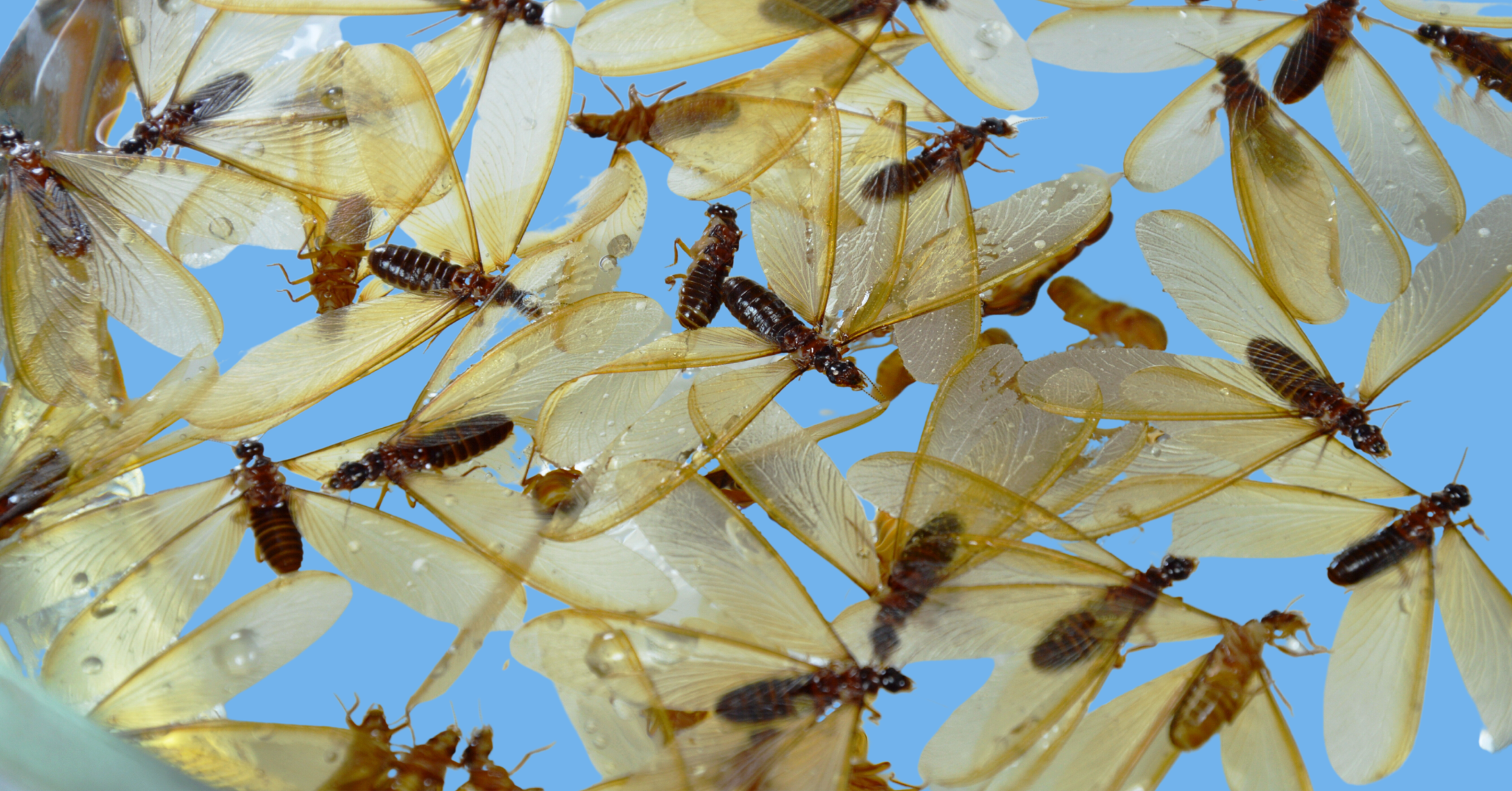What Bugs Look Like Flying Termites?

Flying termites (order Isoptera), also known as alates, are small yellow-brown insects with smoky gray or brown wings. They are around ¼ to ⅜ inches long and are the primary reproductive members of termite species.
If you see alates in your home, there could be a greater infestation within your walls or somewhere you’ve yet to notice. Calling in professionals, like our experts at Moxie Pest Control, can help get them back under control.
However, not all flying insects are termites, so how can you identify whether you have a termite infestation? How do you know when you’re looking at ants, lacewings, beetles, or another kind of pest rather than a termite that could be eating through your home’s wooden structures?
Here’s what you need to know.

WHAT DO FLYING TERMITES LOOK LIKE?
Flying termites are ¼–¾ inches long. They are normally yellowish or brown, but they have smoky gray or brown wings. Termite alates have straight antennae. They have chubby waists that don’t pinch in, and they have four wings of the same size that are longer than their bodies. The wings have veins that may be apparent if you get close enough.
Termites have soft bodies, even when winged. They’re also social insects, so you may see multiple winged insects together (or groups of nonwinged and winged insects in the same colony).
There are several kinds of termites, such as drywood or subterranean termites. Still, they largely look the same other than a few minor differences:
- Subterranean termites (Rhinotermitidae family) have smoky wings with two primary veins. They have square or rectangular cells on their wings.
- Drywood termites (Kalotermitidae family) have three heavy veins on their wings. Their wings have trapezoidal cells.
- Formosan termites (Coptotermes formosanus Shiraki) have hairy wings, setting them apart from other species.
Most termites are yellow, white, gray, or brown in color, though they may also be black.
WHERE DO THEY LIVE?
Flying termites (and termites in general) live in different places depending on the species. Subterranean species lay eggs in soil but may live in dry woods, while drywood termites live and nest in dry wood, as the name suggests.
HOW DO THEY ACT?
Subterranean termites build tubes or tunnels made of soil, saliva, and wood. You may see these structures running up the side of a home’s foundation, for example. The tubes help keep the termites sheltered in a moist environment as they travel in and out of the nest.
Drywood termites nest in the wood and may not be easily identified since they can live within the walls of homes with no outward signs.
NOTABLE INFORMATION
Flying termites are not necessarily the only reproductive termites. In fact, secondary reproductive termites may not be winged at all.

WHAT ARE WINGED BUGS THAT LOOK LIKE FLYING TERMITES?
There are several winged insects that look like termites. Some of them can be just as damaging to your property, but many are not. Still, if there is an infestation of any insects, it’s a good time to look into pest control services for proper identification and elimination.
Insects that resemble flying termites include:
- Winged Ants: They have narrow waists, elbowed antennae, and uneven wings. Found outdoors, they gather in high places when looking for mates.
- Carpenter Ants: Larger ants that nest in wood, often found in damp areas like decaying wood, and can damage wooden structures.
- Powderpost Beetles: Wood-boring beetles that make small holes in hardwood, leaving behind wood dust as they burrow.
- Mayflies: Short-lived insects with short antennae and threadlike tails. They live near water, and their adult form doesn’t feed.
- Green Lacewings: Light green insects with transparent wings, often found in temperate and tropical regions. They are mostly solitary and feed on nectar or other insects.
Identifying features include body shape, wing size and structure, and the presence of a narrow waist.
GET HELP FROM PROFESSIONALS AND GET RID OF TERMITES
If you have termites in your home or there are flying pests that you want to get rid of, give our pest control experts a call. We’ll help identify the pests and aid you in reclaiming your peace of mind.
At Moxie Pest Control, we’re committed to helping our neighbors have comfortable homes where they can relax without worrying about insects. We’re here to help—get your free quote today.
SOURCES
- https://www.learnaboutnature.com/insects/ants/flying-ants/
- https://www.thespruce.com/controlling-the-winged-carpenter-ant-2656698
- https://entomology.ca.uky.edu/ef616
- https://texasinsects.tamu.edu/green-lacewing/
- https://www.britannica.com/animal/mayfly
- https://www.beebetternaturally.com/blog/2020/8/23/green-lacewings-in-the-bee-better-naturally-teaching-garden
- https://texasinsects.tamu.edu/termite/
AUTHOR BIO
Courtney Enzor has worked in the pest control industry for about a decade. From helping you build a fly trap to giving you the best tips for identifying various bugs, she loves answering all your pest-related questions and sharing her pest-related expertise through writing. At the end of the day, she hopes her content will help people avoid mishaps and keep families happy and healthy!

